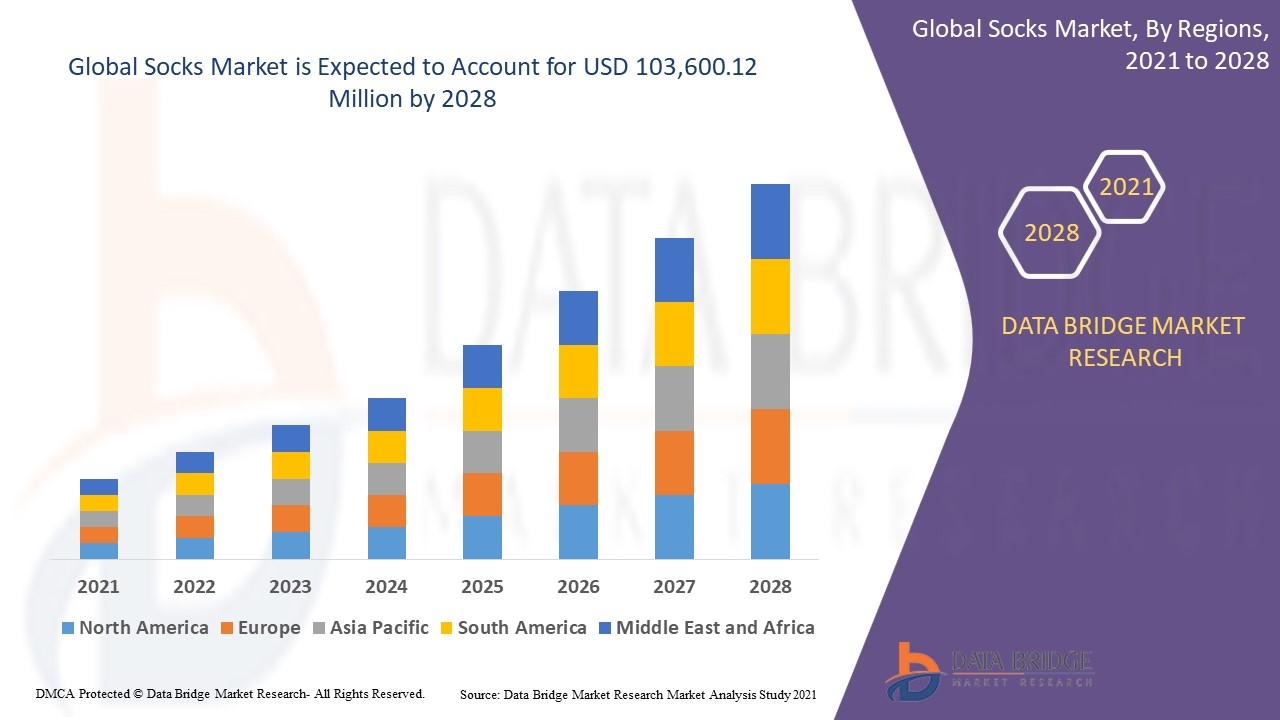From Function to Fashion How the Socks Market Is Stepping Into the Spotlight

Introduction
The global socks market plays a vital role in the apparel and fashion industry, blending comfort, functionality, and style. Once considered a basic clothing necessity, socks have evolved into a fashion statement and a performance-enhancing accessory. From everyday wear to specialized athletic and medical socks, the market has diversified significantly over the years. This transformation is driven by evolving consumer lifestyles, growing awareness about foot health, and the integration of innovative materials and technologies.
In recent years, the demand for socks has surged worldwide, supported by rising disposable incomes, fashion consciousness, and expanding e-commerce platforms. Consumers are increasingly viewing socks not just as essentials but as extensions of personal expression and comfort. Moreover, the rise of sustainable and eco-friendly fabrics is influencing purchasing behavior, leading manufacturers to innovate with organic cotton, bamboo fiber, and recycled polyester.
The socks market contributes significantly to the global textile economy, with consistent growth observed across both developed and emerging markets. The expansion of athletic footwear and outdoor apparel segments, along with urbanization and population growth, has strengthened the global market outlook.
Stay ahead with crucial trends and expert analysis in the latest Socks Market report. Download now: https://www.databridgemarketresearch.com/reports/global-socks-market
Market Overview
The global socks market has shown steady expansion over the past decade. In 2024, the market was valued at several billion dollars and is projected to continue its upward trajectory through 2032. This growth is primarily driven by the increasing importance of fashion accessories, heightened hygiene awareness, and advancements in fabric technology.
Asia-Pacific dominates the global socks market, led by China, India, Japan, and South Korea, where large-scale textile manufacturing and cost-effective labor support production efficiency. North America and Europe remain key consumption hubs, driven by strong demand for premium, branded, and functional socks. Additionally, rising sports participation rates in these regions have fueled growth in performance-oriented socks designed for activities such as running, cycling, and hiking.
The market’s evolution has been shaped by a combination of technological advancements and consumer trends. Smart socks—embedded with sensors to monitor fitness and foot health—represent a growing niche segment. Meanwhile, the increasing adoption of sustainable materials reflects a global push toward eco-conscious apparel manufacturing.
Key Market Drivers
-
Rising Focus on Foot Health and Comfort:
Growing awareness about foot hygiene and comfort has significantly influenced consumer choices. Moisture-wicking fabrics, compression designs, and antibacterial treatments are gaining popularity, particularly among athletes and health-conscious consumers. -
Expanding Sports and Fitness Culture:
The surge in global sports participation and fitness activities has increased the demand for specialized socks that provide cushioning, ventilation, and arch support. Sports brands have capitalized on this trend by launching performance-oriented collections tailored for different activities. -
Fashion and Lifestyle Influence:
Socks are now seen as fashionable accessories, with bold patterns, colors, and designer collaborations shaping consumer demand. Luxury fashion brands and fast-fashion retailers alike are diversifying their product lines to include stylish and themed socks. -
E-Commerce Growth and Customization:
Online retail channels have significantly boosted global sales, offering a wide variety of designs and sizes. The rise of direct-to-consumer (D2C) brands allows for greater customization, subscription models, and seamless purchasing experiences. -
Sustainability Trends:
Eco-friendly socks made from organic cotton, bamboo, and recycled fibers are gaining traction. Consumers are increasingly willing to pay a premium for environmentally responsible products, prompting manufacturers to adopt greener production methods.
Market Segmentation
The socks market can be segmented based on product type, material, end-user, and region.
-
By Product Type:
The market includes casual socks, athletic socks, formal socks, and specialty socks. Athletic socks dominate the segment due to growing sportswear demand, while casual socks continue to lead in everyday wear. Specialty socks—such as compression and diabetic socks—are gaining popularity for their functional benefits. -
By Material:
Key materials include cotton, wool, nylon, polyester, bamboo, and others. Cotton remains the most widely used material, valued for its softness and breathability. Bamboo and synthetic blends are increasingly adopted for their durability, elasticity, and moisture-wicking properties. -
By End-User:
The market caters to men, women, and children. Men’s socks account for the largest share due to higher consumption volume and broader style range. However, the women’s segment is expanding rapidly, driven by fashion trends and increased product variety. -
By Region:
-
Asia-Pacific: The leading producer and exporter of socks, supported by robust manufacturing infrastructure and rising domestic demand.
-
North America: A major consumer base driven by lifestyle trends, sports participation, and premium product demand.
-
Europe: A mature market emphasizing sustainability and high-quality materials, particularly in countries like Germany, Italy, and the UK.
-
Latin America and Middle East & Africa: Emerging markets with growing urban populations and rising disposable incomes.
-
Competitive Landscape
The socks market is highly competitive, featuring a mix of global brands, regional manufacturers, and niche startups. Leading players include Nike Inc., Adidas AG, Puma SE, Under Armour Inc., Hanesbrands Inc., Gildan Activewear Inc., and Renfro Brands. These companies leverage innovation, strong distribution networks, and branding strategies to maintain their market presence.
Prominent strategies among key players include:
-
Product Innovation: Introduction of smart socks, anti-odor technology, and performance-driven materials.
-
Collaborations and Partnerships: Fashion collaborations and sports sponsorships enhance brand visibility and consumer engagement.
-
Sustainability Initiatives: Companies are focusing on eco-friendly fibers, recycled packaging, and ethical labor practices to appeal to environmentally conscious consumers.
-
Expansion through E-Commerce: Major brands are strengthening their online presence to reach broader audiences and introduce personalized shopping experiences.
Regional brands are also thriving by focusing on niche markets, such as handmade or sustainable socks, offering locally sourced materials and artisanal craftsmanship.
Challenges and Restraints
Despite steady growth, the socks market faces several challenges:
-
Rising Raw Material Costs:
Fluctuations in the prices of cotton, wool, and synthetic fibers affect production costs, leading to price volatility. -
High Competition and Price Sensitivity:
The presence of numerous manufacturers creates intense competition, often resulting in price wars, especially in the mass-market segment. -
Counterfeit Products:
The availability of low-quality, counterfeit socks undermines brand reputation and market stability. -
Environmental Concerns:
Traditional textile manufacturing processes are resource-intensive. Companies must address issues related to water consumption, dyeing pollution, and waste management to meet sustainability goals. -
Changing Consumer Preferences:
Rapidly shifting fashion trends require continuous innovation, posing challenges for inventory management and forecasting.
Future Outlook
The global socks market is expected to witness healthy growth in the coming years, driven by innovation, sustainability, and changing lifestyles. Between 2025 and 2032, the market will likely expand further as brands integrate technology, comfort, and design diversity into their offerings.
Smart socks with embedded sensors, capable of tracking steps, temperature, and even posture, will gain traction in both sports and healthcare applications. Meanwhile, demand for organic and biodegradable materials will push manufacturers toward sustainable production models.
E-commerce will continue to be a dominant growth channel, supported by social media marketing and influencer collaborations that highlight new styles and product benefits. Customization, including personalized sock designs and subscription-based sales models, will enhance consumer engagement and brand loyalty.
As global awareness of foot health increases, the market for medical-grade and compression socks will also expand. Moreover, emerging economies in Asia, Africa, and Latin America will provide significant opportunities due to their growing middle-class populations and rising fashion consciousness.
Overall, innovation, sustainability, and comfort will define the next chapter of the global socks market, with brands striving to balance performance and environmental responsibility.
Conclusion
The global socks market has evolved from a simple necessity into a dynamic and fashion-forward industry. Continuous innovation, consumer awareness, and sustainable practices are reshaping its trajectory. With advancements in materials, technology, and design, the market promises exciting opportunities for both established brands and new entrants.
As demand for comfortable, functional, and stylish socks continues to grow, manufacturers are focusing on eco-friendly production and smart technologies to cater to evolving consumer expectations. The future of the global socks market is bright, driven by innovation, sustainability, and the enduring appeal of comfort and style.
Frequently Asked Questions (FAQs)
1. What is the growth rate of the global socks market?
The global socks market is projected to grow at a steady compound annual growth rate through 2032, supported by rising demand for premium and sustainable products.
2. Which region is expected to dominate the socks market in the future?
The Asia-Pacific region is expected to maintain its dominance due to strong manufacturing capabilities and expanding domestic demand.
3. Who are the leading players in the global socks market?
Key players include Nike Inc., Adidas AG, Puma SE, Under Armour Inc., Hanesbrands Inc., and Gildan Activewear Inc.
4. What are the major challenges faced by the socks market?
The main challenges include rising raw material costs, intense price competition, environmental issues, and counterfeit products.
5. What are the future opportunities in the socks market?
Opportunities include smart socks, sustainable materials, customization, and growing demand in emerging markets.
Browse More Reports:
Asia-Pacific Cold Sore Treatment Market
Middle East and Africa Cold Sore Treatment Market
North America Colorants Market
Europe Colorants Market
Asia-Pacific Colorants Market
Middle East and Africa Colorants Market
Europe Colorectal Surgical Devices Market
North America Colorectal Surgical Devices Market
Middle East and Africa Colorectal Surgical Devices Market
Asia-Pacific Colorectal Surgical Devices Market
North America Container Security Market
Egypt Cyber Security Market
Europe Dental Instruments Market
North America Dental Instruments Market
Asia-Pacific Dental Instruments Market
Middle East and Africa Dental Instruments Market
North America Diagnostic Imaging Equipment Market
About Data Bridge Market Research:
An absolute way to forecast what the future holds is to comprehend the trend today!
Data Bridge Market Research set forth itself as an unconventional and neoteric market research and consulting firm with an unparalleled level of resilience and integrated approaches. We are determined to unearth the best market opportunities and foster efficient information for your business to thrive in the market. Data Bridge endeavors to provide appropriate solutions to the complex business challenges and initiates an effortless decision-making process. Data Bridge is an aftermath of sheer wisdom and experience which was formulated and framed in the year 2015 in Pune.
Contact Us:
Data Bridge Market Research
US: +1 614 591 3140
UK: +44 845 154 9652
APAC : +653 1251 975
Email:- corporatesales@databridgemarketresearch.com
- Art
- Causes
- Crafts
- Dance
- Drinks
- Film
- Fitness
- Food
- Παιχνίδια
- Gardening
- Health
- Κεντρική Σελίδα
- Literature
- Music
- Networking
- άλλο
- Party
- Religion
- Shopping
- Sports
- Theater
- Wellness



